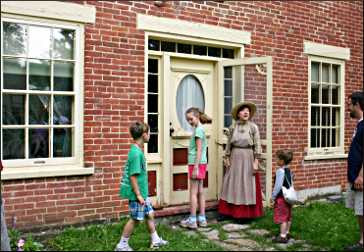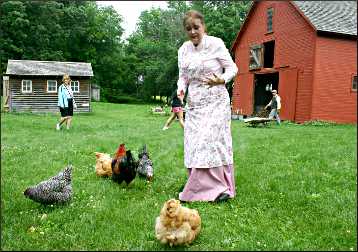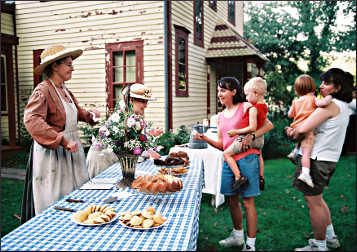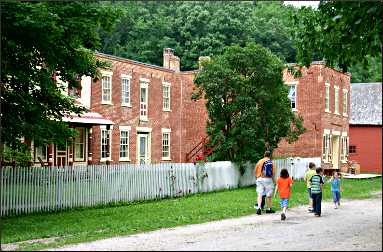Brigadoon in bluff country
At Historic Forestville, visitors are transported back to 1899.

© Beth Gauper
In Minnesota, people value their own history so much that the Minnesota Historical Society was founded nine years before the state itself.
No wonder the state's living-history sites are among the best in the nation.
At a fur post, logging camp and fort, tourists get a peek into the past, and schoolchildren learn their heritage at the feet of lumberjacks, voyageurs, soldiers and farmers.
One of my favorite spots is in southeast bluff country — Historic Forestville, a rural village in which time stopped in 1899.
The frontier folk are friendly and hospitable, but every time I go there, they gently chastise me for showing up in my underwear. The last time was no exception.
"I see you haven't properly covered your limbs," said hired-help Mary Maloney, looking at my shorts in the general store. "Of course, I know times have been hard."
In 1899, this rural village near Preston was fighting for its life. "I hope you'll consider settling here," Maloney said hopefully, after she greeted us.
The postal service had started delivering mail to farmers, who no longer had to visit the village store to get it. The railroad had bypassed Forestville in 1868, and when people began leaving, Felix Meighen and his son Thomas bought up their property and turned it into a company town.
Thomas Meighen closed the store in 1910, but he didn't sell it or its inventory. Thanks to him and his daughter, Margaret, the Minnesota Historical Society was able to turn their home, store and other buildings into Historic Forestville, with interpreters playing the part of the people who lived there.
Gardener Gottlieb Winter still cultivates chicory, citron melons and ground cherries in the riverside garden, near an Ohio buckeye likely planted by orator William Jennings Bryan, once the dinner guest of Thomas Meighen (pronounced MEE'an).
Laborer Charlie Martin tends chickens and cuts wood, and Charles Ball tends the store, offering to sell calico, 5 cents a yard, to the many women who walk in wearing nothing but their "drawers."

© Beth Gauper
Mary Meighen is too polite to mention the ladies' attire, though she herself is properly dressed in ankle-length dress and petticoats. Apologizing for her husband's absence, she graciously shows her guests into the parlor and serves sugar cookies just baked by the cook, Florie Yaste.
They were all real people in 1899, the year the historical society stopped time in Forestville. And they're real people today to thousands of visitors who stream across a russet steel bridge to learn what life was like in rural America.
Forestville, to which visitors must walk from a hidden parking lot across the South Branch of the Root River, is perhaps the most charming of Minnesota's historic sites.
It's hard to get the interpreters out of 1899, and they assume you're from 1899, too.
In the general store, where many of the goods are left over from 1910, Maloney showed us how we could make real coffee — scandalously expensive at $1 a pound — last longer by adding "essence of coffee," or chicory, only 5 cents a can.
And she showed us the stiff, sharp-cornered men's collars: "If my husband falls asleep in church, his chin hits it and it wakes him right up," she said with relish.
In the barn, the largest in Fillmore County when it was built, hired-hand Louis Grabau showed us a new buggy, complete with suspension, which he was readying for his boss to take into Preston.
"Mr. Meighen is fond of his Sears & Roebuck catalog," he said with a wink.
He also showed us how to shuck corn, which we tried to feed to the heritage chickens. They'd been entertaining us all morning with their odd leaps and dashes around the yard, led by a rooster named Bill, for current president William McKinley.
"They're not interested if you come out of the place with the corn, only if you come out of the gates with bread or cake," said kitchen assistant Nellie Moyles.
She recruited Mary Meighen from the kitchen, and sure enough, Bill ran right out of the barn, followed by the hens and chicks.

© Beth Gauper
Another year, I was there for an Evening of Leisure. In the yard of the Meighen house, Thomas' sister Martha Meighen and Florie were serving slices of steamed pudding, ginger cookies and tin wedding cake with chunks of citron melon.
Nellie was playing croquet with a young guest, and Charles Ball was leading a game of horseshoes. On the other side of a white picket fence, people cantered by on horses.
On the lawn, Gottlieb was entertaining guests on an upright bass, with friends on mouth harp and guitar. Soon we all were standing in a circle doing what the musicians announced was the Twirly Whirly, a "new dance from New York City" — what we call these days the Hokey Pokey.
"I haven't been this dizzy since the last time I went to Wykoff," announced handyman John Maloney, to which a scandalized Martha Meighen replied, "Oh, Mr. Maloney!"
Maloney liked whiskey, and thanks to Thomas Meighen's exhaustive records, the staff knows exactly how much of it he bought from the store, if not from the saloon in Wykoff. In the store, there's a replica of the ledger, copied in ink by park staff and open to the corresponding date in 1899.
By 8 p.m., the musicians were playing by lantern light, fog was rolling in over the fields and everyone was singing "My Bonnie Lies Over the Ocean."
Over by the fence, a St. Paul woman and her teen-age niece were playing checkers around a wooden barrel.
"It gets you to thinking," she said. "Nowadays, kids are stuck to the TV, bored, saying, 'What am I gonna do?' It amazes me — I don't think people today get where their parents and grandparents come from. I wish my folks would've shared with me what it was like then."

© Beth Gauper
Trip Tips: Historic Forestville in southeast Minnesota
Getting there: The park is between Spring Valley, Wykoff and Preston, not far from Lanesboro.
From Minnesota 16 south of Wykoff, head four miles south on County Road 5, then two miles east on County Road 118. Historic Forestville can be reached only through the park.
Admission and hours: It's open Thursday through Sunday from Memorial Day weekend to Labor Day, then Saturdays until mid-October. Admission is $10, $8 for children 5-17. State-park vehicle permits also are required.
Accommodations: There are five camper cabins with screened porches as well as camping in [Forestville/Mystery Cave State Park](https://www.dnr.state.mn.us/state_parks/park.html?id=spk00148#homepage, which is known for its trout fishing and horse-riding trails.
The park also has the advantage of having very few mosquitoes in summer, thanks to the excellent drainage provided by the porous limestone right under the surface.
Cave tours: Tours are offered of Mystery Cave near the campground as well as Niagara Cave, just to the east near Harmony.
For more, see Cave country.